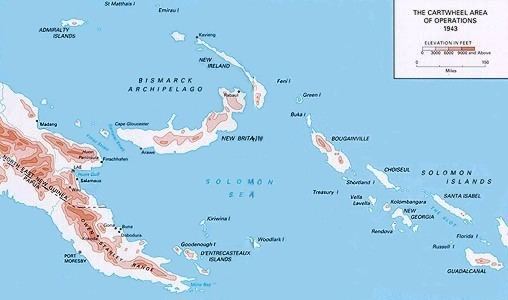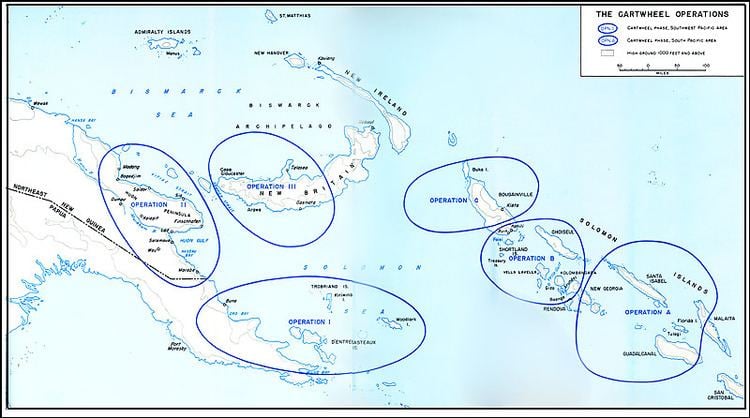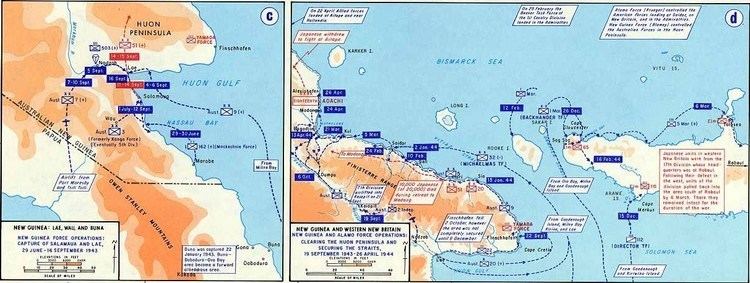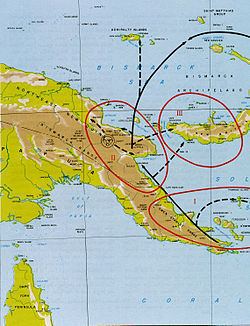Start date 1943 | ||
 | ||
Similar New Georgia Campaign, Battle of Rabaul, Bougainville Campaign, Salamaua–Lae campaign, Huon Peninsula campaign | ||
Operation Cartwheel (1943–1944) was a major military operation for the Allies in the Pacific theater of World War II. Cartwheel was an operation aimed at neutralizing the major Japanese base at Rabaul. The operation was directed by the Supreme Allied Commander in the South West Pacific Area (SWPA), General Douglas MacArthur, whose forces had advanced along the northeast coast of New Guinea and occupied nearby islands. Allied forces from the Pacific Ocean Areas command, under Admiral Chester W. Nimitz, advanced through the Solomon Islands toward Bougainville. The Allied forces involved were from Australia, the Netherlands, New Zealand, the US and various Pacific Islands.
Contents

Background to Operation Cartwheel

Japanese forces had captured Rabaul, on New Britain, in the Territory of New Guinea, from Australian forces in February 1942 and turned it into their major forward base in the South Pacific, and the main obstacle in the two Allied theaters. MacArthur formulated a strategic outline, the Elkton Plan, to capture Rabaul from bases in Australia and New Guinea. Admiral Ernest J. King, the Chief of Naval Operations, proposed a plan with similar elements but under Navy command. Army Chief of Staff George C. Marshall, whose main goal was for the U.S. to concentrate its efforts against Nazi Germany in Europe and not against the Japanese in the Pacific, proposed a compromise plan in which the task would be divided into three stages, the first under Navy command and the second two under MacArthur's direction and the control of the Army. This strategic plan, which was never formally adopted by the U.S. Joint Chiefs of Staff but which was ultimately implemented, called for:


The protracted battle for Guadalcanal—followed by the unopposed seizure of the Russell Islands (Operation Cleanslate) on 21 February 1943—resulted in Japanese attempts to reinforce the area by sea. MacArthur's air forces countered in the Battle of the Bismarck Sea from 2–5 March 1943. The disastrous losses suffered by the Japanese prompted Admiral Isoroku Yamamoto to initiate I Go (Operation 'I'), a series of air attacks against Allied airfields and shipping at both Guadalcanal and New Guinea, which ultimately resulted in Yamamoto's death on 18 April 1943.
Implementation of Cartwheel

MacArthur had presented Elkton III, his revised plan for taking Rabaul before 1944, on 12 February 1943. It called for an attack by MacArthur against northeast New Guinea and western New Britain, and by Admiral William F. Halsey, Jr. (then in command of the South Pacific Area) against the central Solomons. This plan required seven more divisions than were already in the theater, raising objections from the British. The Joint Chiefs responded with a directive that approved the plan using forces already in the theater or en route to it, and delaying its implementation by 60 days. Elkton III then became Operation Cartwheel.
Cartwheel operations

The Cartwheel plan identified 13 proposed subordinate operations and set a timetable for their launching. Of the 13, Rabaul, Kavieng, and Kolombangara were eventually eliminated as too costly and unnecessary, and 10 were actually undertaken.
The New Guinea Force—under General Thomas Blamey—was assigned responsibility for the eastward thrusts on mainland New Guinea. The U.S. 6th Army—under General Walter Krueger—was to take Kiriwina, Woodlark and Cape Gloucester. The land forces would be supported by Allied air units under Lieutenant General George Kenney and naval units under Vice Admiral Arthur S. Carpender.
In the midst of Operation Cartwheel, the Joint Chiefs met with President Franklin Delano Roosevelt and British Prime Minister Winston Churchill at the Quadrant Conference in Quebec in August 1943. There, the decision was made to bypass and isolate Rabaul rather than attempting to capture the base and attack Kavieng instead. Soon after the decision was made to bypass Kavieng as well. Although initially objected to by MacArthur, the by-passing of Rabaul in favor of its neutralization meant that his Elkton plan had been achieved, and after invading Saidor, MacArthur then moved into his Reno Plan, an advance across the north coast of New Guinea to Mindanao.
The campaign—which stretched into 1944—showed the effectiveness of a strategy which avoided major concentrations of enemy forces and instead aimed at severing the Japanese lines of supply and communication.
